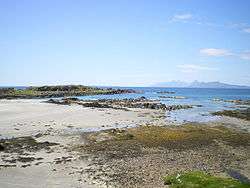Kilmory, Highland
Coordinates: 56°45′22″N 6°02′35″W / 56.756°N 6.043°W
Kilmory (Cill Mhoire in Gaelic meaning "Mary's Cell" or "Church of Mary") is a small crofting (township) hamlet on the north coast of Ardnamurchan, western Scotland.
Geography
Kilmory is reached by a branch road off the B8007 road that runs from Salen to Achosnich by way of Kilchoan. All the roads in Ardnamurchan are single track. There is an excellent view north from the junction with the B8007 to the islands of Rùm, Eigg, Muck and Canna. The road descends gently northwards, crosses the Achateny Water that drains Loch Mudle, passes through Branault and on to Kilmory, Swordle and Ockle.
The branch road that enters Kilmory continues to its end at Balnaha Croft.
A rough track (access on foot only) leads to Kilmory Bay which is an excellent, sheltered bay with clear water, white sands and black, volcanic rock. It is one of the few sandy beaches on Ardnamurchan. Kilmory is overlooked by Dun Mhurchaidh (grid reference NM354706).
Archaeology
A prominent feature in Kilmory is the graveyard. This is said to be the site of the original "Church of Mary", and it is suggested that outlines visible under the grass are part of that structure. Also lying in the grass near the centre of the graveyard is a stone said to be the font stone from the original church. Locally tradition has it that this stone never dries. The graveyard is surrounded by largely circular dry stone wall.
There is a very impressive Standing Stone in the field behind Branault. (NM526695) Whilst the age and significance of this stone are unknown it is interesting to note that it aligns, almost perfectly, with Ben Hiant to the SSE (528m, NM537632, the highest point in Western Ardnamurchan) and Sgurr Dearg (986m, NG443215) to the NNW, the high point at the western end of the Skye Cuillin.
Demographics
Like many other communities in the remote parts of Scotland the population of Kilmory has declined.
There are twenty houses in Kilmory/Branault. As of January 2009, a population of thirteen occupies ten of these houses throughout the year. The other ten houses are used as holiday homes with six being available for short term holiday lets. The average age of the population is 68 years, with the youngest being 46 years.
Services
This decline has been mirrored by a steady decrease in services. In the early part of the 20th Century there was a shop in Branault (Mathieson) and one in Kilmory; up until the 1970s there were weekly visits by two grocery vans(mobile shops)(Burgess from Kilchoan and McColl from Acharacle) as well as the Tuesday butcher's van (Cameron from Acharacle) and the Thursday butcher's van (Connel from Salen).
In 2008 British Telecom threatened to withdraw the service from the one telephone box. As of January 2009 the phonebox still works. Mobile phone reception in Kilmory is very poor as is the terrestrial television signal. There are neither mains water nor mains drains in Kilmory. Kilmory school closed in 1962 and the sub post office was closed in 2004.
There is a notice board in Kilmory which usually lists the times of the Kilchoan Tobermory ferry.
Religion
Kilmory supported two churches. Members of the Free Church of Scotland worshipped in a wooden building set amongst trees to the east of the village whilst members of the Church of Scotland worshipped in Kilmory Church which stands to the south of the village; services ceased here in 1989.
Development Issues
In 2009 and 2010 there has been talk of up to four new houses being built in Kilmory. One of these projects was abandoned as access was too difficult: progress on two others is delayed as there have been problems securing a reliable water supply. The spring from which most of the existing dwellings are provided with water has been deemed to not have sufficient flow to sustain the additional houses. This is ironic in an area of such heavy rainfall

